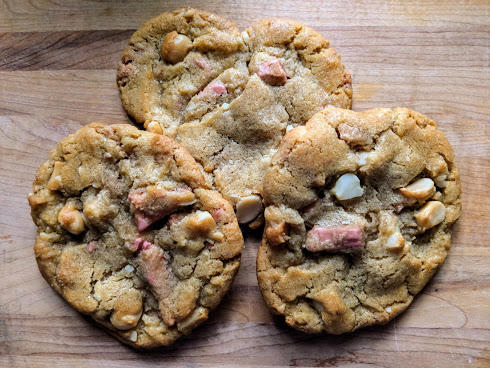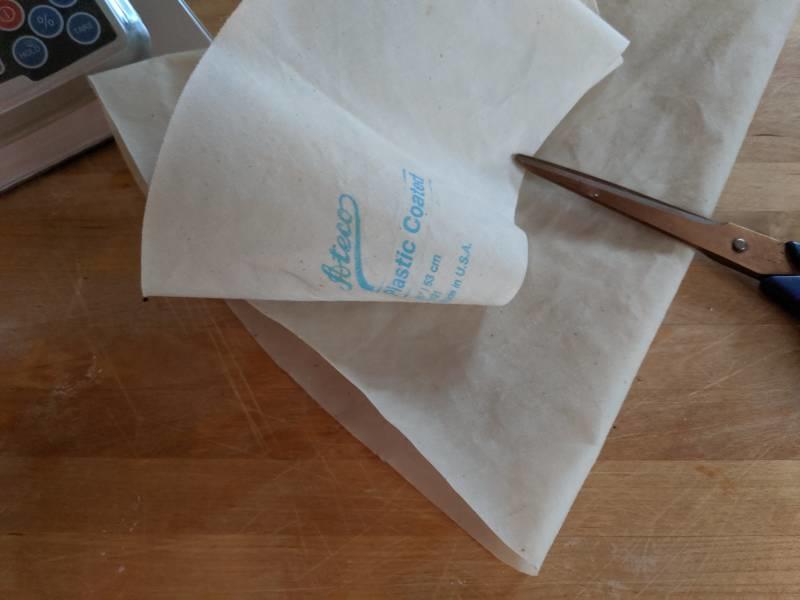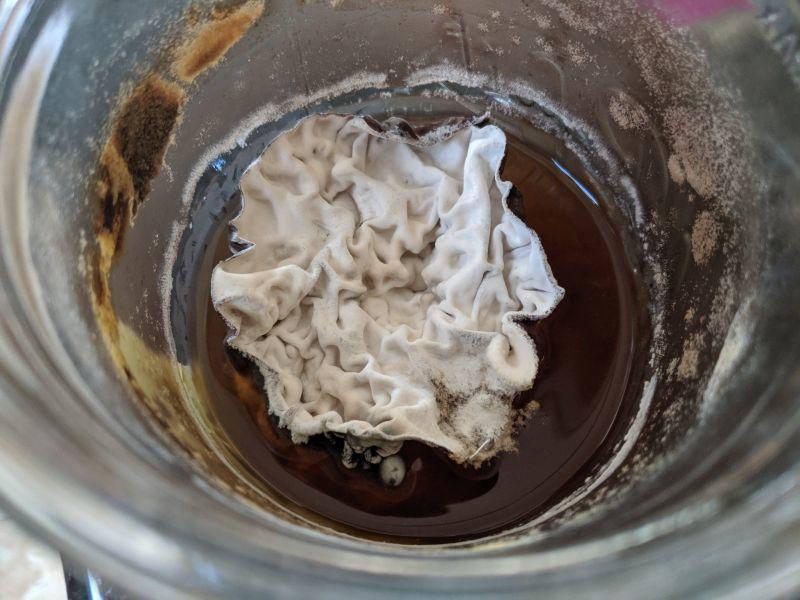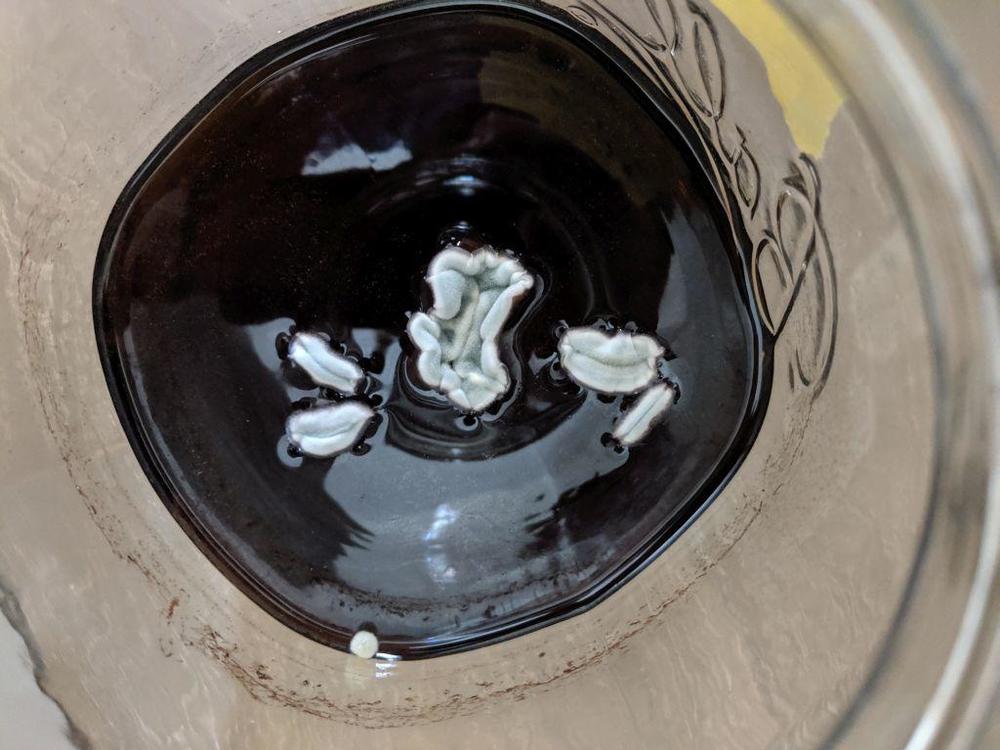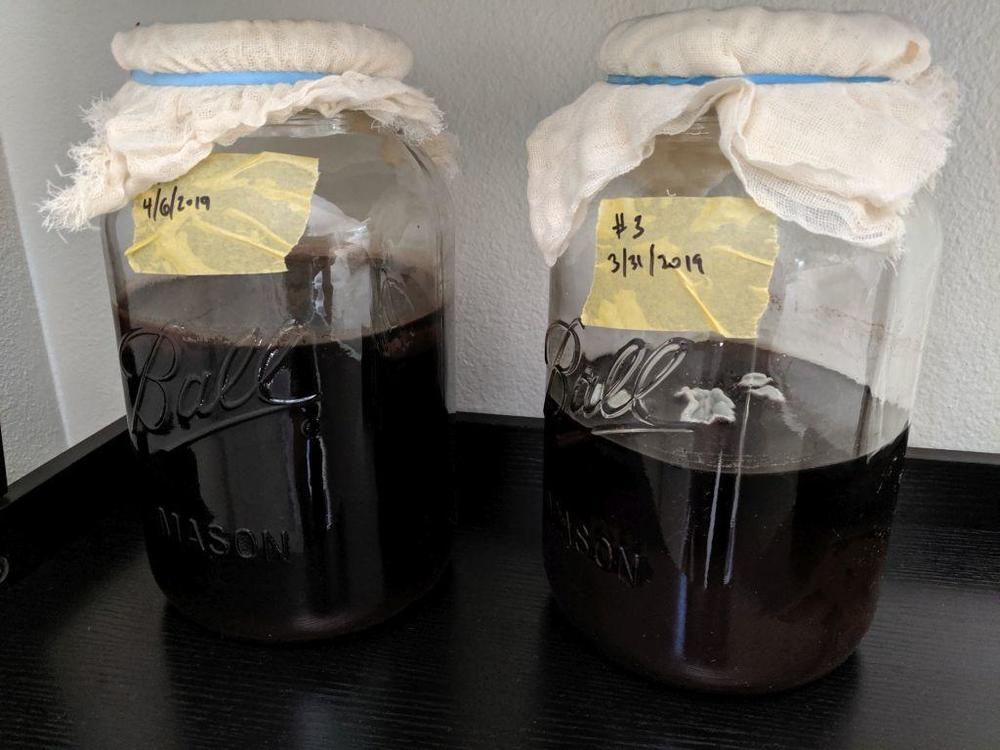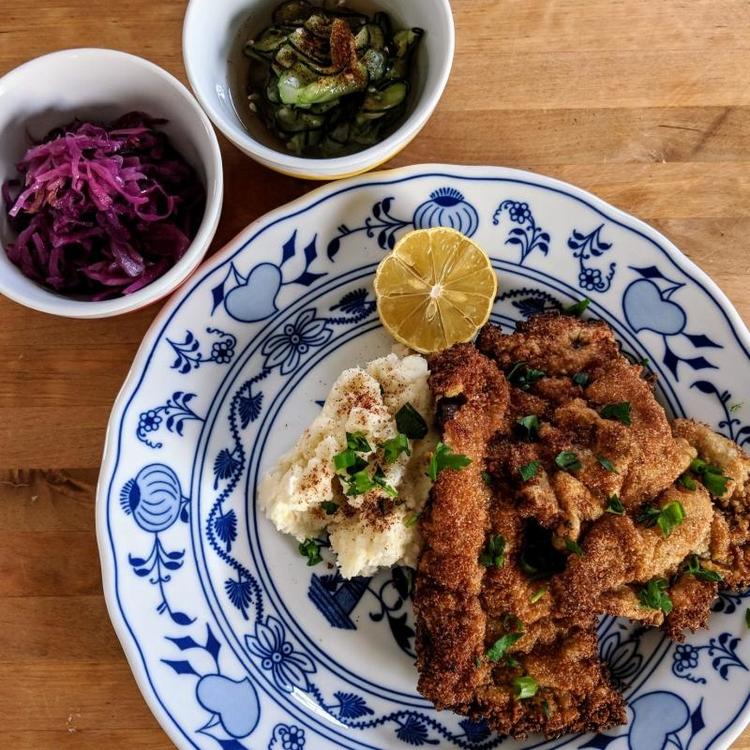
jedovaty
participating member-
Posts
439 -
Joined
-
Last visited
Content Type
Profiles
Forums
Store
Help Articles
Everything posted by jedovaty
-
Thanks, that's helpful, you lay out the foundation and underlying reasons for short vs long proofs, and the use of the commercial yeasts vs home-grown ones. It seems then, that the purpose of omitting the second proof is to remove the flavor component of the yeast/flour/sugar interaction, and then let the ingredients themselves come through. I thought it might be more texture related, too. This is where I shrug and say okay? And thank you for the new term: " viennoiserie" That is precisely what I plan to explore this winter! Slight tangent, and going to explore path of croissant vs kouign aman, as that's a fairly easy comparison for me to capture. Earlier this year, I had a modicum of success with making croissants that used a combination of yeast and sourdough, but was distracted by something else before I could explore further. Many recipes also suggest using an osmotolerant yeast, which I've researched and understand it helps speed up the process a little. I've read that croissants may leak when baked if not proofed correctly (i.e. leak if underproofed; also, understood there may be other factors contributing to the leaking). How does this, then, work for recipes which call for minimal or no second proof, such as the kouign aman? Is the leakage somewhat desired in this case, to "fry" the dough a bit with the sugar? Why is the proof time in some KA recipes removed? Is it to reduce the "chewiness" that could be caused by the extra salt and improve the tenderness of the dough, or to bring more focus onto the flavor of the butter, sugar, and salt? Am I splitting hairs? These questions may simply not have an answer and be rhetorical, and I may just have to run my own tests to see why. Of course, baseline recipe first to have a standard to compare to.
-
Your Daily Sweets: What Are You Making and Baking? (2017 – )
jedovaty replied to a topic in Pastry & Baking
To be clear, it's only with the JT recipe I have this issue. I'm going to try to make them one more time, and if they don't work out, I'll post up as a separate topic so I don't end up derailing this one Also.. maybe the baking soda thing is the reason why you don't like CCCs very much?! I would guess doubling the baking soda could lead to a slightly off taste. -
Hi: I've had decent success with sourdough bread, having found a timing with two rounds of proofing/proving that results in a decent crumb structure and bread that feels light compared to its size. I'm starting to cautiously branch out to other yeast-leavened doughs/pastries now, and have run across a few recipes that don't make sense from my perspective of a two-stage proof because they leave out the second proof, i.e. after a bit of time chilling in the fridge, the things are baked right away. Why? I'm also guessing these types of recipes probably won't work well using a natural leaven like sourdough...??? Soon as I have time, I plan to try baking a loaf of bread as the first rise comes close to completion, I'm really curious to see what happens, but I'm not so inclined to test on other recipes because most of them are a lot of work (e.g. kouign amann, given all the time involved in rolling out, etc ugh). Thanks for your time!
-
Your Daily Sweets: What Are You Making and Baking? (2017 – )
jedovaty replied to a topic in Pastry & Baking
Hi there, I'm a little late on response. Yours look just right and delicious, and like you, I find these better the next day, after they have cooled down and "rested". But unlike you, I can eat and have eaten a whole batch of chocolate chip cookies in one sitting (forget delayed gratification!!). While I'd like to suggest trying different chocolates in the mix at once, based on history of reading all your posts here I think I'd be preaching to the choir If you haven't done so, try that, use different chocolates, and also, maybe try using a little less than the recipe calls for. Or, instead, make small, bite-sized ccc, these are always very popular at my office. For chocolate, I usually use my own left-over dark chocolates (~70% no dairy, wipe out the chocolate from the melanger, mix with the ones that don't quite make full mold, and press out 1/4" sheets between parchment), and sometimes chunks of left over hazelnut/chocolate failed ganaches, or etc. Also, I've made a JT-based ccc recipe with strawberry white chocolate and macadamia nuts. However, I've found the JT recipe to make very greasy cookies.. I can't seem to get them them quite right, I have tried reducing butter or increasing flour. Any suggestions? Someone else stated they enjoy shortbread cookies.. to that person and to you, try the Alison Roman shortbread chocolate chip cookies, they are quite good. -
Done! Makes it so much easier to use. I see the point of disposables, though, cleaning choux pastry out was quite a PITA. Also, my first attempt at pastries and choux au craqueline, I can't believe I've never had these before, quite delicious!
-
Interesting, okay! I've used the bag a total of 7 or 8 times since purchased in 2016. Just discovered choux pastry, so I may end up using it more depending just how fun they are to make. The top is not sewn or hemmed or finished in any way that I can tell. I'll perform the topbagectomy tomorrow and if there's time, try my first shot at profiteroles and eclairs. Wish me luck. 🤡
-
Hi: I sincerely apologize for the extremely frivolous nature of this topic!! I purchased a 21" ateco piping bag that is cloth outside and plastic inside a few years back, on recommendation from a store clerk when I was learning to make french macarons. It's worked well, but way way too big for pretty much everything I've tried to pipe. I can easily buy a smaller bag (or use ziplocks of course), they are inexpensive at $4-8, and then either keep the 21" or throw it out. But... can I just cut the top down to make it smaller? I'll lose the logo and stamped button hole for hanging, but who cares? I just don't like waste, rather reuse what I have... feels real stupid to post this sorry and not sure why this is so agonizing haha 😐😧
-
That sounds awesome. Questions, as this is my first time reading vinegar being canned: 1. Did you can the vinegar in order to halt the process and preserve for long time? 2. Will age on the canned product have any impact (i.e. could it be different in 2, 5, 10 years?) 3. Does the canning change flavor of the vinegar at all? 4. Canning kills nearly everything if not everything, so this would no longer be a "probiotic" type flavoring? (I wonder if vinegar with live cultures is even considered "probiotic" since it's no lacto fermented, right?) #4 is kind of a stupid question, I know, I just may be influenced a little with current fads having lacto-fermented foods, live cultures, etc. I'll admit I am a little bit of a product of marketing 😛
-
Absolutely correct. At that time, I decided to do it this way mostly because it was an interesting experiment to watch the salt appear (wish I had filmed it). I was also too lazy to do the additional math to figure out how much I actually needed of each ingredient for the dishes I was playing with, and couldn't find my scale that's accurate to the 0.1g. So many excuses 😛 With an hour or two of evaporation, I now have a tin of this sodium citrate salt Solution or salt, they both work!
-
I followed the instructions in that reddit post a year or so ago because I had the ingredients on hand and didn't want to wait for delivery. It works. I did most of the boiling on the stove, then transferred to a parchment lined baking sheet in the oven and let it finish baking in there (larger surface area). I wasn't sure how the boiling down would work in the pot, whether it would scorch or damage it which explains the oven. I'm not sure if parchment is water proof and could be some chance of a reaction with the aluminum sheet pan and left over citric acid if measurements are right. You end up with crystals and powder.
-
Isn't fish that's just slaughtered a little dangerous to eat, from the perspective of parasites? It's been my understanding, perhaps an incorrect one, that fish needs to be held at sub 0 temps for X number of hours to kill the parasites - and this is what makes typical "sushi" grade fish.
-
I went back to look at the progress of my two remaining tubs, and sadly, as Andiesenji would have predicted, they didn't work out. One of them had a massive mold growing on top.. it was solid, had weight to it. It's actually kind of pretty, maybe a mushroom of sorts?! I want to call it the evil vinegar step-mother?! All has been tossed, and I'll give in and start a vinegar using a commercial mother and/or a vinegar with active culture in it already.
-
Yeah, it's sous vide that opened up a whole world of not only improved textures, but also foods cooked to lower temps (and not necessarily via sous vide). When reading about beef and pork smoking, I mostly see 250-300F temps, while cold smoking usually for fish and charcuterie. I'll give it a go, setting up a long smoke @250 or so with a kettle seems to be "easy" with the snake method. I'll look into cold smoking after this first step. Wish me luck that I don't burn down the neighborhood 😲
-
Interesting timing on this resuscitated thread, I've just started learning about charcoal grilling and smoking, first grill to start this weekend, and then I'll try smoking the following weekend. One thing really bugging me about not-cold-smoking: am I going to actually like it? Not sure. I've learned I do not like texture of red meat beyond medium rare, and pork past medium. I've had some braised meats, and while tasty, the texture has always been off-putting. Is that what I will experience if I smoke 250-300F ?
-
Yeaaaahhhhh I think that dude(ette) is referring to a standard vacsealer, not a chamber. I use my old (OLD) foodsaver at least weekly, and I can do basic flash pickling using small mason jars and the jar sealer quite well. I get lost in the specs, and want one that does it all, but then those go way beyond what I want to pay. Such as retort canning. When am I actually going to retort can?! Pffft.
-
What's a CSO? I've really wanted a chamber vacsealer for several years now, but, I get "paralysis by analysis" and end up postponing the purchase. If I had pulled the trigger long ago, I'd have it by now. Ugggghhhhhh.
-
Thank you, this is what I was looking for. The wine we made 20 years ago was from our garden that had about 100 grapevines, and a small ~25 tree orchard or so. It was semi-rural at the time, however, the surrounding area has since grown in considerably. I was hoping to make vinegar from the old wine, but looks like it will be a no-go, bummer! Based on the rest of what you wrote, to make sure I have this right: one cannot make a mother out of bottled wine. If I wish to make a vinegar mother from scratch, then one needs to continue with the fermentation process, instead of bottling the wine. I wonder what in the bottling process stops the acetobacter? Does the lack of oxygen kill it? I thought that would just inhibit the growth, make it lay dormant, then revive once exposed again. Or maybe if the wine maker adds sulfites or other preservatives/sanitizers, this kills the acetobacter? Hmmm. In other words, why is it a chemical reaction only that created vinegar in your wine instead of promoting the continued fermentation?
-
Thanks for the information! As I mentioned in both my above posts, perhaps not clearly enough, I am not interested in making a vinegar this way. I'm trying to create the mother without a starter culture, similar to the way people makes a starter sourdough culture, or a ginger bug, etc. If you search for "how to make vinegar", nearly all results provide similar instruction to simply purchase Bragg's or some other vinegar with active cultures and go from there. Again, this is not what I want to do. My inner mad-scientist wants to do things the hard way Sadly, I haven't found any instructions or details/info on this yet. Thanks again for trying to help out, though, it's appreciated!
-
Thanks, TT and DT. I got rid of it. Now to continue waiting, hoping the mother will spontaneously will itself into existence some day. Funny how I cannot find any information on how to do this anywhere...!
-
Hi! Question 1: Check out the odd growth in my attempted vinegar mother in the photos.. what is it, should I throw it out, scoop it off and continue? Question 2: Is it possible to actually make one's own vinegar mother? Backstory for question 1: Having recently read the Noma guide to fermentation, I got this great idea that I would try to make my own vinegar mother. My inner mad scientist loves to do things the hard way. 20 year ago my father and I made and bottled wine from garden grapes. It's been stored in the basement since. I opened a bottle and it tasted astringent and had a sharp aroma similar to isopropyl alcohol, but still had some reminiscence to wine. According to everything I've read, it would be best to drop the alcohol level from typical wine to about half (I forget the percentages at the moment, it's been 4 months). I had no clue what alcohol level this wine was when we bottled it, since it was done seat of the pants style. Assuming it had typical wine alcohol volume, I diluted it with distilled water at 1:1 ratio. I also stuck a stone fish bubbler in there. The bubbler disintegrated in about 6 weeks, this was about 2.5 months ago. When I removed the bubbler back then, I tasted the liquid, just for laughs, and it was "meaty", in sort of a salami kind of way? Fun. Now, it's been left untouched since and I even forgot about it. Today I happened to go into the room, and saw the growth. I'm suspecting I contaminated the experiment with either the bubbler or the when I tasted the liquid (I may have double dipped... oops.. but I don't remember, and I don't think I'd do something that stupid, but, who knows). If it were the bubbler, not sure why the other jar is fine. Comment on Question 2: I know I can purchase a vinegar with live cultures and use that to start a mother. Not interested in doing this the easy way, and instead, would like to try to get one to spontaneously create itself from this old wine. Still have about 20 bottles to experiment with 🤪 Anyone have tips how to do this? Searching internet doesn't give much more useful information beyond buying something already live. I keep this in my downstairs spare bedroom, temp ranges 68-75F. Humidity is usually about 70%, but drops if I run the AC (as i have in the last couple weeks). Thanks for reading and any suggestions
-
Yes, I use salted butter The DL method uses sugar [davidliebovitz.com] during the turns, while the various youtube videos from france simply add all the sugar when the laminating butter is added (example here [youtube], there are several more with similar techniques, some of them super messy, don't care about tears, exposed butter, etc). I wonder if my sugar is too coarse? It's not fine, but rather large and granular, similar to demerrera. I'll take pictures of the wetness next time I try to make this.
-
Thanks all for the replies. I went a cautionary way and added a couple generous dallops of honey while creaming/mixing butter with less sugar, and it was indeed soft, and was pliable after set in the fridge. Thanks for this, that makes sense! I got the creaming idea for laminated dough by following the chef steps' kouign amann. Had no idea you could just mix the honey and butter. I am really curious now to try ghee with honey, since there's no water in ghee... hmmm I've been successful in making decent croissants over the last couple weeks, so I think my technique is improving. The moment I add sugar to the butter and/or dough, it starts to feel wet, and whether sitting in the fridge or on my counter, I can feel the moisture increasing. Moving the dough off my counter top leaves wet syrup spots. My relative humidity averages about 60%, I am coastal, less than 1/2 mile from the beach. We've had rain the last few weeks so it's been higher, even with the heater/conditioner running. For the kouign amann, I've tried traditional recipe variations (roll in butter with sugar into left over bread dough, followed by 2-3 rapid turns), as well as David Liebotvitz and Chefsteps. The Chefsteps technique by creaming ended up smearing all over my counter at the last turn, and was more puff pastry than anything. Best results were from the traditional method, as it's pretty quick, although, I still got syrup during the short, ~40min proof before bake.
-
Hi: what happens if I cream butter with honey? Will the butter hold up, chilled? Or just be a soft mess? I would just try it, however, I only have a little precious expensive local honey on hand. Purpose is to play with laminated doughs... Sugar doesn't have the water it it, but it is hygroscopic (and when I add it to, say my kouign amann dough, the dough starts weeping syrup pretty quick). Honey already has the water in it. Hmm.. thanks for your input
-
Hi, thank you for the replies. I went ahead and gave it a shot this weekend. The meat was antelope, haha, sorry about missing an important piece, D'OH! It was already quite tender after smashing to about 1/8" , so I did not do a long sous vide, only an hour at 132F. Resulting texture of the meat was tender and moist, if a tiny bit chewy. As long as I didn't breathe, it tasted like a mild meat.. the "rusty" aroma of this meat was a bit off putting, maybe next time a marinade in something acidic would be helpful. I've got one pound of "ground select" left, I don't think it is ground yet, so I need to figure out what to do with it (not chili or spaghetti).


